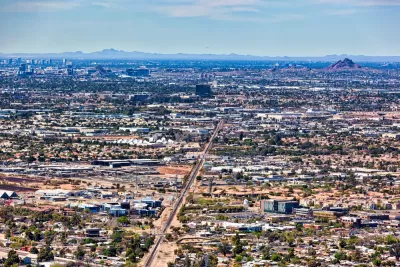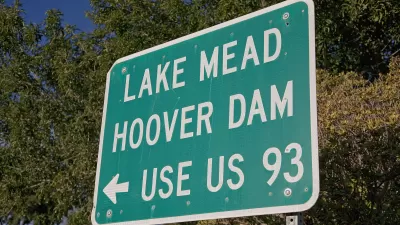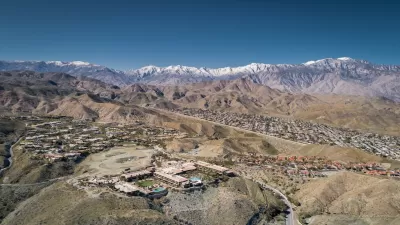Phoenix is growing, it's now America's fifth largest city, but its water supply is shrinking.

New suburbs are sprouting up all around Phoenix but new water supplies are not. "Twenty years ago, Anthem sprung out of virgin desert, a community 'masterplanned' from scratch with schools, shops, restaurants and spacious homes – many behind high walls and electronic gates – and its own country club and golf course," Joanna Walters reports for The Guardian.
The city is growing, it's now the country's fifth largest city, and that population needs water. Walters cites a Federal Bureau of Reclamation report from 2012 that says the city will experience droughts of five years or more every decade from now until 2050. But the region has been slow to act. "Greater Phoenix has not declared any water restrictions. Nor has the state government decided its official drought contingency proposal," Walters writes.
Building in the desert means bringing water from distant sources, "… Phoenix gets less than eight inches of rainfall each year; most of the water supply for central and southern Arizona is pumped from Lake Mead, fed by the Colorado river over 300 miles away," Walters reports. Bringing water uphill from that shrinking lake uses a lot of power, and though the city enjoys more than 300 days of sun a year, only between 2 to 5 percent of the state of Arizona's power comes from solar.
Meanwhile, growth continues. "Another firm wants to build a 'masterplanned community', like Anthem, south of Tucson, and modelled after the hilltop towns of Tuscany. It envisages five golf courses, a vineyard, parks, lakes and 28,000 homes," Walters reports.
FULL STORY: Plight of Phoenix: how long can the world’s 'least sustainable' city survive?

Planetizen Federal Action Tracker
A weekly monitor of how Trump’s orders and actions are impacting planners and planning in America.

San Francisco's School District Spent $105M To Build Affordable Housing for Teachers — And That's Just the Beginning
SFUSD joins a growing list of school districts using their land holdings to address housing affordability challenges faced by their own employees.

The Tiny, Adorable $7,000 Car Turning Japan Onto EVs
The single seat Mibot charges from a regular plug as quickly as an iPad, and is about half the price of an average EV.

Seattle's Plan for Adopting Driverless Cars
Equity, safety, accessibility and affordability are front of mind as the city prepares for robotaxis and other autonomous vehicles.

As Trump Phases Out FEMA, Is It Time to Flee the Floodplains?
With less federal funding available for disaster relief efforts, the need to relocate at-risk communities is more urgent than ever.

With Protected Lanes, 460% More People Commute by Bike
For those needing more ammo, more data proving what we already knew is here.
Urban Design for Planners 1: Software Tools
This six-course series explores essential urban design concepts using open source software and equips planners with the tools they need to participate fully in the urban design process.
Planning for Universal Design
Learn the tools for implementing Universal Design in planning regulations.
Smith Gee Studio
City of Charlotte
City of Camden Redevelopment Agency
City of Astoria
Transportation Research & Education Center (TREC) at Portland State University
US High Speed Rail Association
City of Camden Redevelopment Agency
Municipality of Princeton (NJ)





























